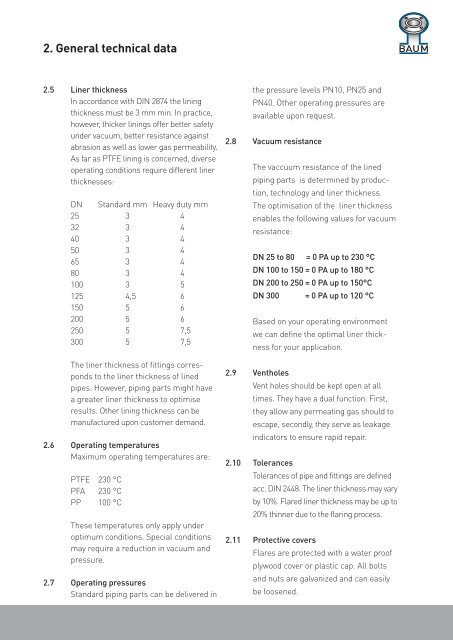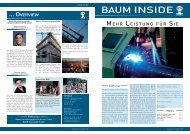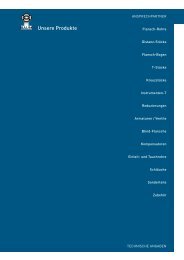Catalogue DIN - Baum Kunststoffe GmbH
Catalogue DIN - Baum Kunststoffe GmbH
Catalogue DIN - Baum Kunststoffe GmbH
You also want an ePaper? Increase the reach of your titles
YUMPU automatically turns print PDFs into web optimized ePapers that Google loves.
2. General technical data<br />
2.5 Liner thickness<br />
In accordance with <strong>DIN</strong> 2874 the lining<br />
thickness must be 3 mm min. In practice,<br />
however, thicker linings offer better safety<br />
under vacuum, better resistance against<br />
abrasion as well as lower gas permeability.<br />
As far as PTFE lining is concerned, diverse<br />
operating conditions require different liner<br />
thicknesses:<br />
DN Standard mm Heavy duty mm<br />
25 3 4<br />
32 3 4<br />
40 3 4<br />
50 3 4<br />
65 3 4<br />
80 3 4<br />
100 3 5<br />
125 4,5 6<br />
150 5 6<br />
200 5 6<br />
250 5 7,5<br />
300 5 7,5<br />
The liner thickness of fittings corresponds<br />
to the liner thickness of lined<br />
pipes. However, piping parts might have<br />
agreater liner thickness to optimise<br />
results. Other lining thickness can be<br />
manufactured upon customer demand.<br />
2.6 Operating temperatures<br />
Maximum operating temperatures are:<br />
PTFE 230 °C<br />
PFA 230 °C<br />
PP 100 °C<br />
These temperatures only apply under<br />
optimum conditions. Special conditions<br />
may require a reduction in vacuum and<br />
pressure.<br />
2.7 Operating pressures<br />
Standard piping parts can be delivered in<br />
the pressure levels PN10, PN25 and<br />
PN40. Other operating pressures are<br />
available upon request.<br />
2.8 Vacuum resistance<br />
The vaccuum resistance of the lined<br />
piping parts is determined by production,<br />
technology and liner thickness.<br />
The optimisation of the liner thickness<br />
enables the following values for vacuum<br />
resistance:<br />
DN 25 to 80 = 0 PA up to 230 °C<br />
DN 100 to 150 = 0 PA up to 180 °C<br />
DN 200 to 250 = 0 PA up to 150°C<br />
DN 300 = 0 PA up to 120 °C<br />
Based on your operating environment<br />
we can define the optimal liner thickness<br />
for your application.<br />
2.9 Ventholes<br />
Vent holes should be kept open at all<br />
times. They have a dual function. First,<br />
they allow any permeating gas should to<br />
escape, secondly, they serve as leakage<br />
indicators to ensure rapid repair.<br />
2.10 Tolerances<br />
Tolerances of pipe and fittings are defined<br />
acc. <strong>DIN</strong> 2448. The liner thickness may vary<br />
by 10%. Flared liner thickness may be up to<br />
20% thinner due to the flaring process.<br />
2.11 Protective covers<br />
Flares are protected with a water proof<br />
plywood cover or plastic cap. All bolts<br />
and nuts are galvanized and can easily<br />
be loosened.




